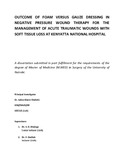| dc.description.abstract | Objective: Negative pressure wound therapy (NPWT) has been widely used for a variety of wounds with good outcomes. However, it is contraindicated in the management of wounds with cerebrospinal fluid (CSF) leakages. The reason is the fear of a sudden shift of CSF fluid as a result of suction leading to brain herniation or coning. There is a paucity of data to either support or negate such claims. We aimed to determine the effect of NPWT in the management of patients with wounds with CSF leakages.
Method: This was a longitudinal prospective study of patients having wounds with CSF leakages managed with NPWT in our institute. Outcome measures evaluated were changes in the level of consciousness, Glasgow Coma Scale (GCS) score, length of hospital stay, mean effluent collected, time taken for the wounds to heal/close and complications related to NPWT.
Results: A total of 12 patients with wounds that had CSF leakage were managed with NPWT over two years. Of the patients, nine had wounds in communication with the brain, with three patients having spinal cord wounds. The average effluent collected on the first day of applying NPWT was 510ml, and by the third day this had fallen to approximately 200ml. The mean time taken for wounds to close was 12.3 days. There was no evidence of herniation nor any other morbidities or mortalities reported in any of our patients.
Conclusion: NPWT, as indicated in this series, had a beneficial effect in the management of wounds with CSF leakage. NPWT, once applied to the wound, caused a tamponade effect that resulted in stoppage of the leakage of the CSF and did not lead to suction of the fluid, as previously thought. The dressings ensured an airtight system, preventing communication between the wound and the external environment, thus reducing sepsis while awaiting definitive wound closure. | en_US |


